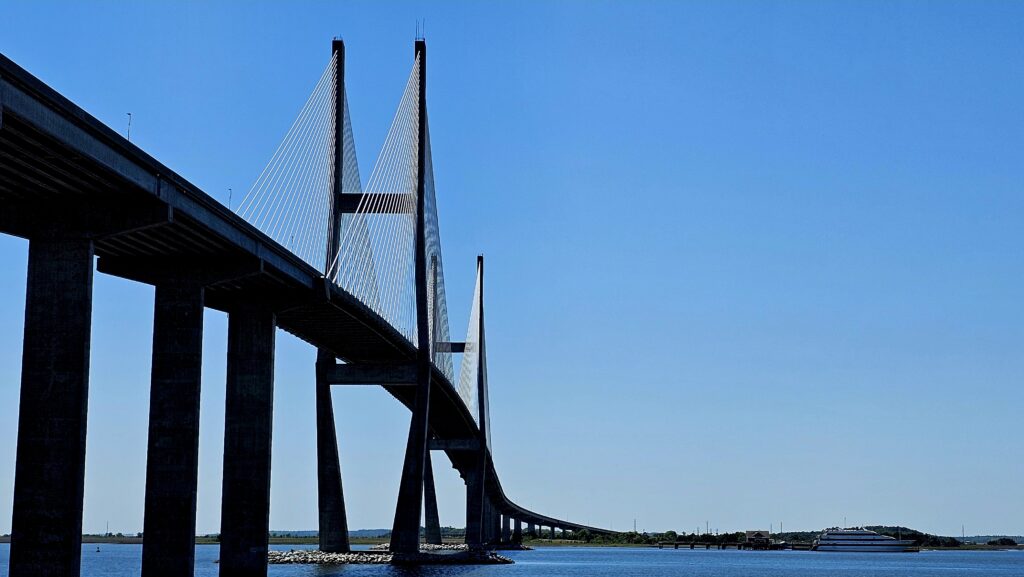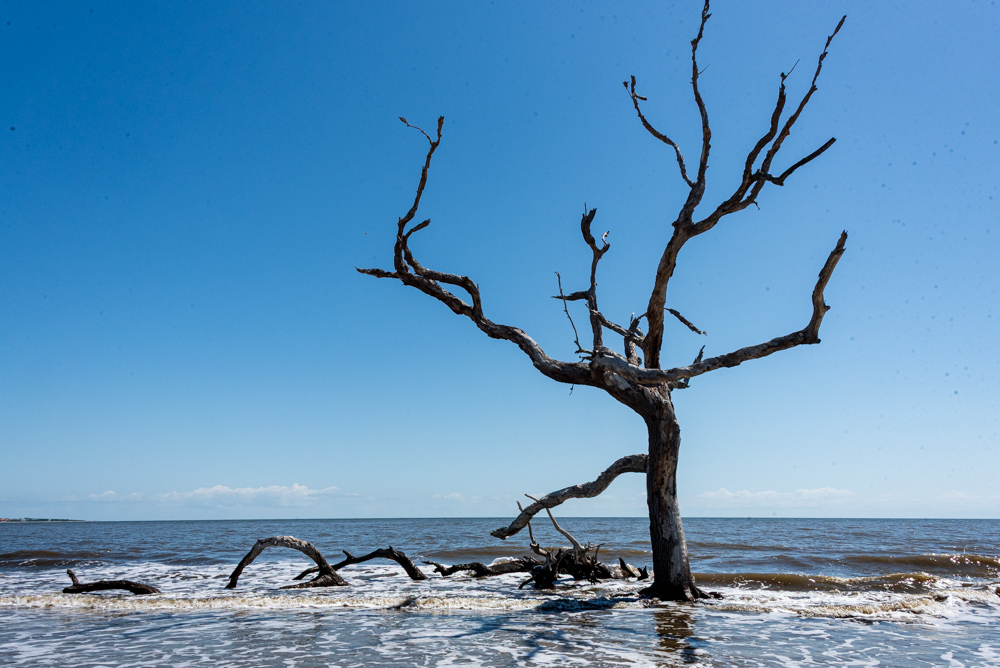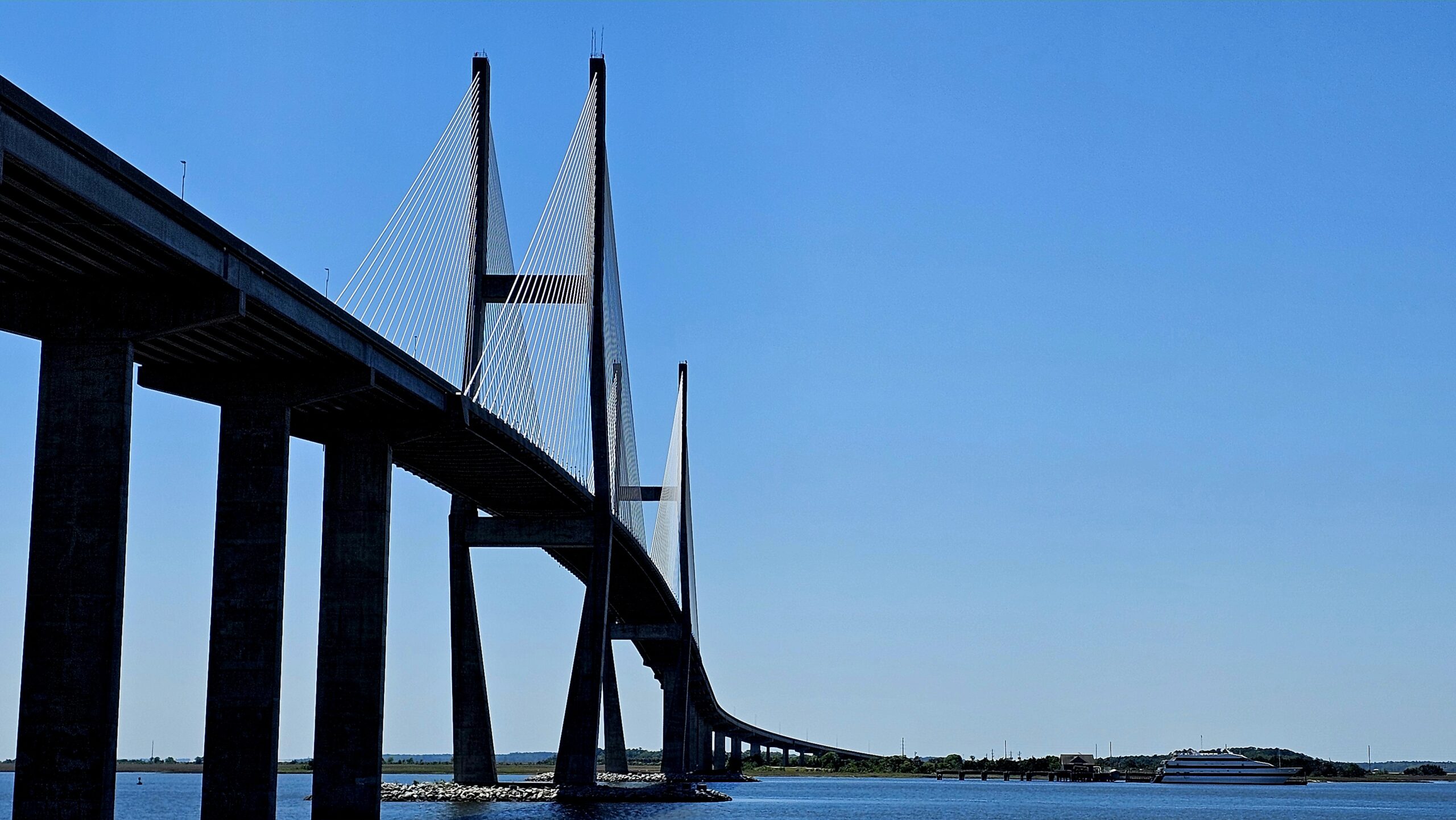We’ve all heard the phrase “less is more”—but few understand its power better than those who live and shoot minimally.
Sometimes, less is more. Whether in life or in photography, simple is sometimes freeing and you get to see the best of where you are.
Living in a travel trailer is minimalist living. Dishes, gear, clothes, …hair products (well, let’s not talk about THOSE!) but most everything is pared down to the basics. And sometimes that is true for photography as well. There are times that I am impressed with the starkness of an image and know that it will work well with less clutter around.

The above image of Sydney Lanier Bridge in Brunswick, GA was one of those times. Taken just with my cell phone, I loved the clean lines, the beautiful midday light and the absence of clouds that would have detracted from the image.
Let’s explore how minimalist living—the art of simplifying life to focus on what truly matters—mirrors the visual and emotional impact of minimalist photography, and how embracing one can enhance the other.
🧘♂️ The Philosophy: Focus and Intentionality
Minimalist living is about clearing the clutter to make room for clarity. It’s saying “no” to the excess so you can say a louder “yes” to what brings value.
In minimalist photography, the same rule applies. By eliminating distractions in your frame, you guide the viewer’s attention with intention. Whether it’s a single tree in a vast snowy field or a solitary figure bathed in shadow and light, every element earns its place.
When you live simply, you train your mind to see differently. You become more intentional—not just with your possessions, but with your compositions. You start asking: What really needs to be in this frame?
If you’re a photographer drawn to clean lines, empty space, and purposeful composition, chances are you’ve already been seduced by minimalist photography. But what if I told you that the key to elevating your minimalist shots might not lie in new gear or editing techniques, but in your lifestyle?
This image of Driftwood Beach on Jekyll Island, Georgia illustrates the “less is more” philosophy. Stark lines and the absence of sunset colors or clouds create a minimalist image.

🏡 The Space: Negative and Physical
A minimalist home has breathing room—solid color walls, natural light, and carefully chosen pieces. Likewise, a minimalist photo thrives on negative space. It’s not empty; it’s alive with meaning. I have always loved negative space in an image. Whether it is a portrait or a landscape, negative space can speak volumes.
Photographers who embrace minimalism often describe how their lifestyle influences their visual work. A clutter-free environment fosters a clutter-free eye. You’re not overwhelmed by choices—you’re attuned to form, light, and emotion.
Try this: the next time you declutter a room, take a moment to observe how light plays on the surfaces. What shadows emerge? What colors stand out? That’s your next photo. In my last condo, the light was just fantastic. I would often get lost in watching the shadows play across the room as the sun moved throughout the day.
🧳 The Gear: Quality Over Quantity
Minimalist living often means owning fewer things—but choosing ones that are versatile, high-quality, and meaningful.
It’s the same in photography. You don’t need a bag full of lenses to make stunning images. A single prime lens and a trained eye can go further than any camera body upgrade. Just like minimalist living, minimalist photography asks you to know your tools intimately and push their limits creatively.
Some of the most iconic minimalist photographers—think Michael Kenna or Hiroshi Sugimoto—work with simple setups. What makes their work profound is not gear, but vision.
🔁 The Loop: How Each One Fuels the Other
Here’s the beautiful part: minimalist living sharpens your photographic instinct, and practicing minimalist photography deepens your appreciation for simplicity in life.
You learn to slow down. Observe. Compose with care. Whether you’re arranging a photographic frame or arranging your home, the goal is the same: create space for meaning.
So if you’ve been feeling creatively stuck or overwhelmed by options—maybe it’s time to look into your lifestyle.
🎯 Final Thought
Minimalism in life and art isn’t about restriction—it’s about refinement. It’s not about having less for the sake of less—it’s about choosing what matters most and letting that speak loudly, in silence.
Pick up your camera, simplify your frame, and maybe even your morning routine. You might find that clarity is the best filter you’ve ever used.
SAME POST TAILORED FOR TRAVEL PHOTOGRAPHERS
🌍 Wander Light: What Minimalist Living Can Teach Travel Photographers About Minimalist Photography
If you’ve ever tried to catch a flight with just a carry-on and a camera, you already know: traveling light is liberating.
But what if that same principle could transform your photography too?
For travel photographers, minimalism isn’t just an aesthetic—it’s a lifestyle choice. Whether you’re navigating crowded markets in Marrakech or hiking through Icelandic fjords, the ability to see clearly and pack lightly is your superpower.
Let’s explore how minimalist living and minimalist photography are deeply connected—and how adopting both can elevate not only your images, but your entire journey.
🎒 Pack Light, Shoot Intentionally
Minimalist living is all about cutting excess to focus on what truly matters. It’s the same in travel—and in photography. You learn to choose with purpose: one good lens over five mediocre ones, one perfect shot over fifty forgettable ones.
When you’re on the road, every decision counts. What gear do you bring? What moments do you capture? Minimalist photography is about answering those questions with intention. No clutter, no chaos—just clarity.
Next time you’re on location, ask yourself: What’s the story here? Then strip it down to its essence. That’s your shot.
🌌 Negative Space = Breathing Room
Busy street scenes and epic landscapes can overwhelm the frame—but minimalism teaches you to look for space.
Think of it like this: in the same way that minimalist living creates calm by reducing visual noise, minimalist photography creates emotional impact by isolating your subject. A single figure on a sand dune. A boat on an endless sea. A doorway glowing in a dark alley.
These are the moments that breathe—because they aren’t crammed with distractions.
Pro tip: When exploring a new destination, take a moment to stop and observe the light, the geometry, and the mood. Sometimes the best shot is the quiet one.
🌍 The Freedom of Fewer Things
Travel minimalism means letting go of excess baggage—both literal and mental. When you stop lugging around unnecessary gear, you move more freely, explore deeper, and connect more with your surroundings.
Minimalist photography echoes that mindset. You’re no longer chasing the perfect shot in every corner—you’re waiting, watching, composing. Your focus sharpens. Your creativity expands.
And guess what? You often capture more meaningful images, because you’re not drowning in options. You’re dialed in.
✨ Minimalism as a Creative Lens
Minimalism isn’t about doing less—it’s about doing better with less. It’s about noticing the curve of a shadow on a temple wall, the symmetry of a staircase in Lisbon, the stillness of a morning mist in the Alps.
When you travel with a minimalist mindset, the world opens up differently. You stop photographing everything—and start photographing something.
Minimalist photography teaches you to slow down and see deeply. Minimalist living makes space in your life for that kind of seeing.
🎯 Final Thought
Whether you’re island-hopping in Greece or trekking through Patagonia, one truth holds: what you leave out can be just as powerful as what you include.
So the next time you zip up your backpack and sling your camera over your shoulder, remember:
Travel light. Shoot with purpose.
Minimalism isn’t a limit—it’s an invitation to focus on what truly matters.
Want help picking the best lightweight travel gear for minimalist shooting? Or ideas for a photo series that uses negative space and isolation across global landscapes? Just say the word!
Rediscover what matters through nature
Feeling Overwhelmed or craving stillness? At Finding Nature’s Beauty, we create space to breathe, reflect and reconnect –with yourself and the world around you. Reflections, our newsletter, is designed to help you find calmness and clarity from the stress of everyday living by providing weekly inspiration, stories, and actionable ideas to guide you.
